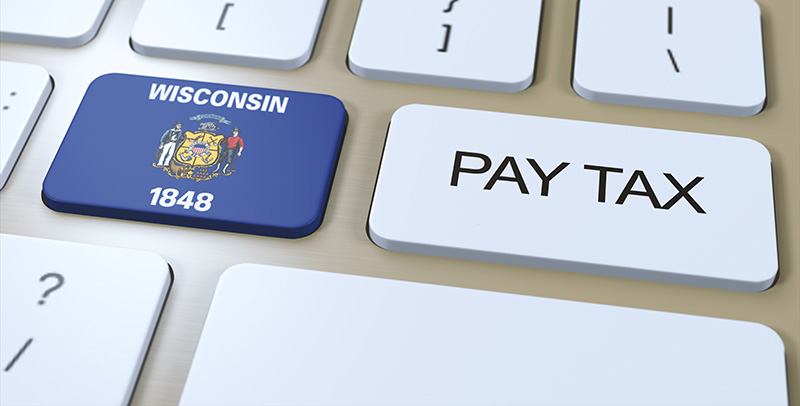Wisconsin Estimated Tax Payments: What You Should Know
August, 02 2024 by Steve Banner, EA, MBA
You are probably quite familiar with the quotation from 1789, known to be attributed to Benjamin Franklin, that says, in part:
- “…in this world nothing can be said to be certain, except death and taxes.”
Although there is some evidence that Franklin was not the original author of this phrase, the thought behind it remains true to this day. We can count ourselves lucky to note that death only comes to us once in our lifetime, but we are not so lucky with regard to income taxes, which we have to face at least once a year. (Of course, I realize that diehard Packers fans who have endured countless heart-stopping moments late in the 4th Quarter at Lambeau Field may dispute the above statement about facing death only once, but I digress.)
Returning to the subject at hand, no matter what type or types of income we might receive, we all know that our precious and hard-earned dollars may be subject to both federal and state taxes. Exactly how much tax we are required to pay – and to whom - depends on many factors that are beyond the scope of this article.
Most of us don’t have to worry too much about paying our taxes throughout the year because our state and federal taxes are taken out of our paychecks before we even receive them. This “pay-as-you-go” withholding process takes place regardless of whether we get paid every week, every two weeks, or every month. This means that when it comes to the end of the year and we prepare our tax returns, we report our taxable income and figure out our correct tax liability for the year. Then, when we compare our tax liability to the total amount that has been withheld by our employers during the year, we find out whether we will receive a refund or whether we owe further amounts to the IRS or state tax agency. In other words, we get a refund if our employer withheld too much for tax, and we get a balance due if the employer withheld too little.
All of this means that for those of us whose only source of income is the regular paycheck we receive from our employer, we only need to deal with our income taxes on an annual basis.
But what would happen if no tax was withheld from our income during the year? Well, unless our income was quite low, we would get a nasty shock because we would owe a lot of money to both the IRS and the Wisconsin Department of Revenue. Not only would we have to pay the regular taxes due on our income for the year, but we may also have to pay penalties and interest.
But that could never happen, right?
Oh yes, it could! For some types of income, tax is not normally withheld before the taxpayer receives it. Think about the exorbitant amount you had to pay the plumber last week to fix your leaking dishwasher just before your in-laws arrived for dinner. You didn’t withhold taxes from the payment you made to the plumber, did you? Of course not. Some types of taxpayers, such as small business owners, independent contractors, freelancers, and other self-employed taxpayers, do not normally have taxes withheld from the payments they receive for their work. Taxes are usually not withheld for taxpayers who receive other types of income, such as rental income, dividend income, capital gains, interest income, and even income from cryptocurrency.
The end result is similar to what would happen if my local self-employed plumber, Larry, received a paycheck at the end of every quarter of the year instead of after each job is completed. At the end of each quarter, he estimates the amount of taxes he owes for that quarter and sends a check to the IRS or to the tax agency of the state where he earned his untaxed income. Just like the rest of us, when Larry completes his tax return at the end of the year, he will find out whether he owes more tax or if he’s due a refund.
Many individual states require the payment of estimated taxes by people like Larry, although the rules tend to differ slightly from one state to the next. Let’s now look at the rules that apply to Larry if he works in Wisconsin.
Wisconsin Estimated Tax Rules for Residents and Nonresidents
Regardless of whether they are a Wisconsin resident for any part of the year, taxpayers who are required to file a Wisconsin tax return and expect to owe more than $500 after taking into consideration any taxes already withheld and allowable credits must either make estimated tax payments or have additional income tax withheld throughout the year from their wages or other income.
Wisconsin estimated tax installment payments are normally due on the following dates unless the date falls on a weekend or holiday. In that case, the payment will be due on the next business day:
- April 15th;
- June 15th;
- September 15th; and
- January 15th of the following year.
The above due dates are different for taxpayers who use a fiscal year rather than a calendar year. In those cases, the first payment is due 3 months and 15 days after the beginning of the taxpayer’s fiscal year, with the next payment due on the 15th day of the 6th month of the taxpayer’s fiscal year, and so on.
The rules are slightly different for taxpayers who earn at least two-thirds of their 2024 gross income from farming or fishing. Although these taxpayers can make quarterly payments like everyone else, instead they may choose to:
- Pay their 2024 estimated tax in full by January 15, 2025; or
- File their 2024 income tax return on or before March 3, 2025, and pay the total tax due. In this case, they need not make estimated tax payments for 2024.
It is important to note that penalties and interest may be charged to taxpayers who do not meet the exception above and fail to make their required estimated payments. The same applies if payments are underpaid or paid late in any quarter, even if the taxpayer is due to receive a refund when they file their income tax return.
Taxpayers will not owe penalties or underpayment interest if their prior-year tax return was for a tax year of 12 full months (or would have been if they had been required to file) and either of the following applies:
- They had no tax liability for the prior year and they were a Wisconsin resident for all of the prior year, or
- They have paid in the smaller of 90% of their current year tax liability or 100% of their prior-year Wisconsin tax liability (unless they did not file a Wisconsin tax return for the prior year).
Taxpayers can use the estimated payment worksheet that is available through the Wisconsin Department of Revenue website to determine their estimated tax liability and how many payments they should make.
Payments may be made electronically through the Wisconsin Department of Revenue Quick Pay or My Tax Account sites, or via mail after printing a payment voucher for Form 1-ES. For more information, refer to Wisconsin Individual Estimated Tax Payments.





